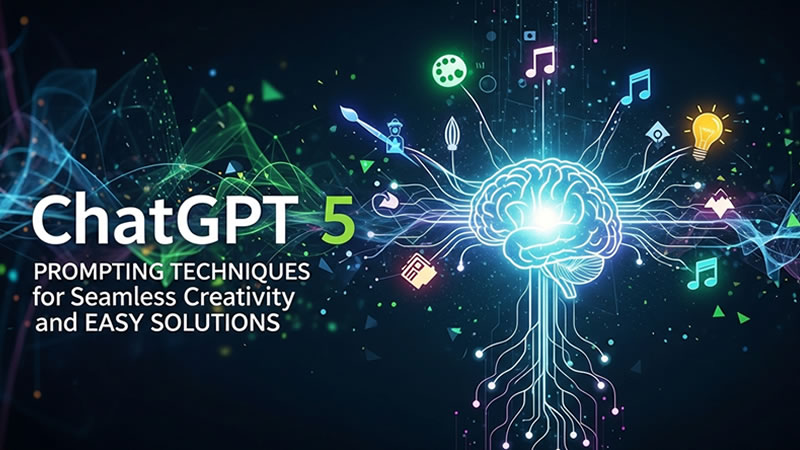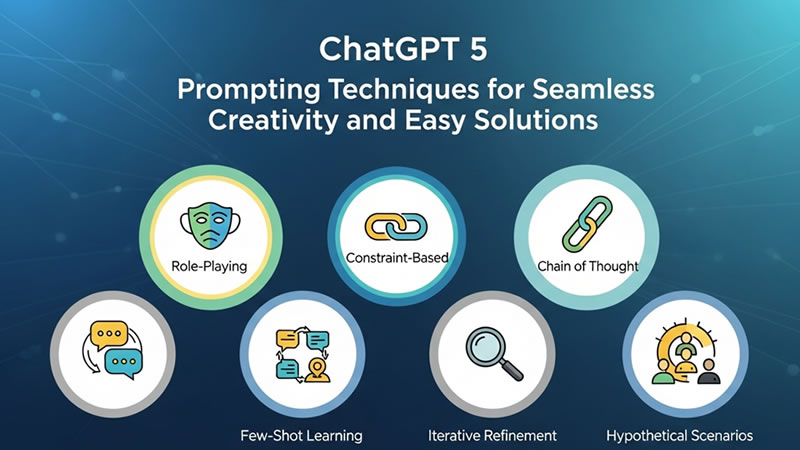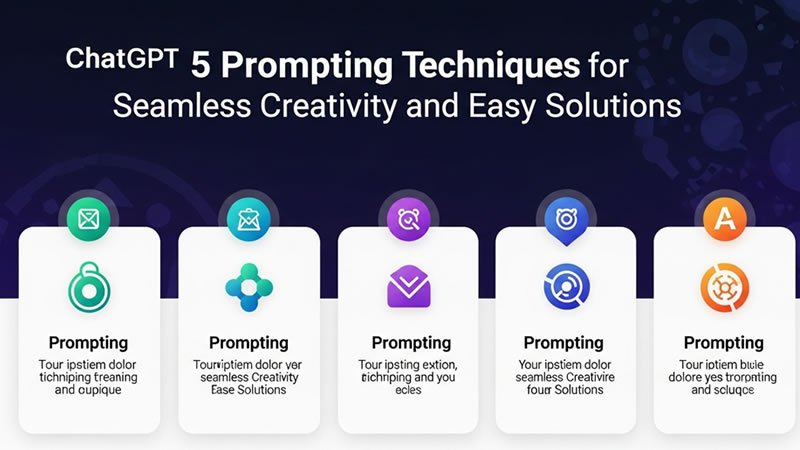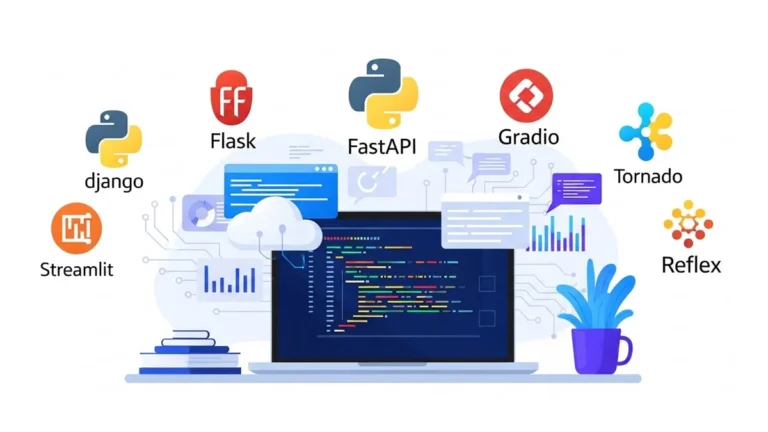ChatGPT 5 Prompting Techniques for Seamless Creativity and Easy Solutions
ChatGPT 5 prompting techniques: What if you could unleash the complete potential of ChatGPT-5, turning it from a basic instrument into a seamless extension of your imagination and problem-solving? Whether you’re developing software, automating processes, or producing accurate insights, the secret lies in one often-ignored ability ChatGPT-5 prompt creation and refinement.

Consider it as speaking the model’s dialect fluently, knowing exactly how to direct its replies toward your objectives. Done properly, it’s not only about improved outputs; it’s about saving time, lowering frustration, and achieving outcomes that feel almost custom-built. In this feature, Matthew Berman breaks down the science and art of building prompts that not only function but excel, enabling you to exploit GPT-5’s strengths like never before.
Learning Effective Prompt Strategies
Within this guide, Matthew Berman offers practical methods to refine how you engage with ChatGPT 5 prompting techniques, from balancing reasoning depth to moderating its autonomous behavior. You’ll discover how to construct prompts that are structured, explicit, and purpose-driven, whether coding with frameworks like React or improving API performance.
Along the way, you’ll identify ways to control verbosity, enhance logical coherence, and even employ GPT-5 as a “met prompter” to polish your own instructions. By the conclusion, you’ll grasp not only how to influence the model’s results but also how to make it an essential partner in your workflows. Ultimately, GPT-5’s power lies not only in what it performs but in how you direct it.
Foundation of Prompt Optimization
Prompt refinement forms the basis of effective GPT-5 application, empowering users to guide the model toward producing outcomes that match set objectives. Through designing clear and accurate prompts, you can mold the model’s responses to your needs. Core strategies include:
- Balancing reasoning effort so replies remain detailed yet efficient.
- Defining explicit criteria for context collection and solution-finding.
- Managing autonomous eagerness to restrict unnecessary decisions and actions.
For instance, when addressing a programming problem, specifying the required level of reasoning and detail can significantly boost clarity and usefulness of ChatGPT 5 prompting techniques. This ensures the model provides actionable insights customized to your task.

Controlling Autonomous Behavior
Managing ChatGPT 5 prompting techniques autonomous nature is vital for assignments requiring freedom. By setting strict boundaries, you can streamline the model’s workflow while retaining command over its operations. Effective methods include:
- Establishing tool budgets to minimize needless exploration and resource waste.
- Defining early stop conditions to avoid excessive cycles and ensure timely delivery.
- Implementing escalation pathways for complex or unclear assignments.
For example, when ChatGPT 5 prompting techniques is prompted to perform research, you can set a maximum number of tool calls and request interim reports. This ensures the process stays efficient, targeted, and aligned with objectives, reducing risks of irrelevant outputs.
Optimizing Tool Usage
The ability of Prompting Techniques to connect with outside tools improves when guided by structured prompts. By customizing how and when updates appear, you enhance clarity, accountability, and efficiency. Strategies include:
- Requesting brief summaries of tool usage to track progress.
- Defining exact tool protocols to guarantee accuracy and consistency.
For example, while working with APIs, ChatGPT 5 prompting techniques can be instructed to summarize every action. This enhances traceability, simplifies verification, and ensures the model’s steps remain aligned with expectations.
Boosting Coding and Front-End Work
ChatGPT-5 demonstrates excellence in programming, especially in front-end development with frameworks like Next.js, React, and Tailwind CSS. To fully utilize its skills, consider:
- Embedding coding standards and modularity within your prompts.
- Guiding the model to follow established design systems for consistency.
- Encouraging self-review rubrics for one-shot coding tasks.

For example, GPT-5 can generate a reusable React component that follows your team’s naming rules and styling preferences, ensuring smoother integration into existing projects.
Iterative Prompt Refinement
Progressive refinement is a reliable method for strengthening ChatGPT 5 Prompting Techniques. Testing and adjusting prompts allows recognition of weak areas and improvement. Additionally, ChatGPT 5 prompting techniques may serve as a met-prompter, helping refine your own guidelines. This process ensures steady improvement and adaptability, making it a long-term tool for optimization.
Ensuring Instruction Clarity
Precise, unambiguous directions are essential for lowering mistakes and preserving logical order in GPT-5’s replies. To guarantee this:
- Avoid contradictory or unclear instructions in prompts.
- Use structured formats to direct reasoning and improve flow.
For instance, when requesting a summary of a report, specify tone, length, and highlights to ensure relevance. This minimizes confusion and increases response quality.
Using Minimal Reasoning Mode
For tasks requiring speed, GPT-5’s minimal reasoning mode delivers concise and efficient responses. By stressing clear planning and shorter outputs, this mode optimizes performance for quick-use scenarios like brief summaries or calculations, where extended reasoning is unnecessary.Improving Readability with Formatting
Well-structured responses improve readability and usability. Directing GPT-5 to apply formatting, such as bullet points or headings, enhances clarity. For instance, structured documentation output looks professional and easy to navigate, ensuring results meet industry standards.
Optimizing API Efficiency
Efficient API use is essential for GPT-5 performance, especially when multiple interactions occur. With features like the “responses” API, you can reuse context and simplify workflows. Important tactics include:
- Reducing token consumption for cost control and efficiency.
- Configuring API calls to balance speed with resource usage.
For instance, prompts can be crafted to reuse context, avoiding repetition. This improves speed and user experience while maintaining seamless conversations.
Fine-Tuning Advanced Settings
Advanced configurations give extra control over GPT-5’s behavior, enabling tailored results. Key factors include:
- Adjusting verbosity for concise or expanded responses.
- Enhancing precision for technical or complex tasks.
For example, GPT-5 can be instructed to create compact summaries for executives or detailed explanations for documentation. This ensures adaptability, making the model’s results perfectly match your objectives.







